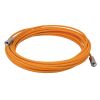Solinst AquaVent SPX Wellhead
Features
- Fits conveniently on 2" well casing with 4" adapter available
- (4) 1.5V AA lithium batteries last up to 8 years with 1 reading per minute
- Contains built-in desiccants with hydrophobic filter for maintenance-free operation
- Free ground shipping
- Expedited repair and warranty service
- Lifetime technical support
- More
Overview
The Solinst AquaVent SPX Wellhead fits conveniently onto a 2" (50 mm) well casing (a 4" Well Adaptor is available). The wellhead has a connection for communicating with Solinst software and accessories, along with an additional connection for communicating with third-party dataloggers or telemetry systems using MODBUS (RS-232/RS-485) or SDI-12 protocols.
Power
Each Wellhead contains four (4) 1.5V AA lithium batteries that power the AquaVent logger. They are user-replaceable and can last 8 years based on 1 reading per minute (the internal AquaVent logger battery is only used to maintain the clock).
Design
For permanent moisture protection, the Wellheads contain multiple built-in desiccants and have a hydrophobic filter where the vented cable terminates at the surface.
- (1) AquaVent Wellhead
- (1) Well sleeve, 2"
- (1) Cable hanger bracket
- Solinst AquaVent Vented Water Level Logger Specifications
- Solinst AquaVent Vented Water Level Logger Manual
- Solinst AquaVent Vented Water Level Logger Quick Start Guide
- Solinst AquaVent Vented Water Level Logger SDI-12 Manual
- Solinst AquaVent Vented Water Level Logger Modbus Manual
- Solinst AquaVent Vented Water Level Logger Cable Maintenance
- Solinst AquaVent Vented Water Level Logger Hardware Compatibility
In The News
Cal Poly, San Luis Obispo Manages Monitoring Efforts in Morro Bay
California Polytechnic State University, San Luis Obispo (Cal Poly, SLO), has been monitoring Morro Bay for decades, and while the monitoring program has changed over the years, the dedication to monitoring the bay has remained the same. The project started in 2006 as a Packard Foundation-funded initiative to monitor water quality flowing in and out of Morro Bay. The goal at the time was to use the data collected to develop and inform an ecosystem-based management plan in collaboration with the Morro Bay National Estuary Program (MBNEP). Since the estuary was the focus at the time, researchers were monitoring water flowing into the estuary from Chorro Creek and Los Osos Creek.
Read MoreGreen Water in Green Bay: Using Data Buoys to Monitor the Southern Bay
While the bay of Green Bay has been referred to as the largest freshwater “estuary” in the world, the watershed hosts intensive agriculture and contributes one-third of Lake Michigan’s total phosphorus load. The Fox River flows into the bay, carrying excess nutrients largely the result of non-point source runoff from the watershed. With a history of deterioration extending well into the last century, the bay ecosystem suffered significant declines in water quality. This, in turn, stimulated major clean-up and ongoing restoration efforts to improve water quality. Tracking these changes is an important aspect of ecosystem management.
Read MoreCross-Border Sewage Contaminated Flows: Monitoring the Tijuana River
The Tijuana River runs across the US-Mexico boundary, flowing into and throughout southern California, carrying with it nutrients and contaminants throughout the estuary. In recent decades, the flows have been heavily polluted with untreated sewage from the City of Tijuana. The wastewater enters the greater Tijuana River estuary, impacting coastal communities and disrupting the natural environment. In order to better understand these cross-border flows, researchers out of San Diego University sought to monitor the waterway test the capabilities of in-situ sensors to measure the contaminated water. Natalie Mladenov and Trent Biggs were two of the researchers involved in the project, deploying a real-time monitoring system in May of 2021.
Read More
























